Viewcast Methodology
Best Practices – Media Viewsheds
A “viewshed”, also known as a "display exposure zone", is the geographical area that includes all points from which an advertisement may be seen by traffic or pedestrians as it moves in various directions around a media unit (display). This methodology was specifically developed for out-of-home (OOH) media measurement and applies universally across all OOH media formats - from traditional roadside billboards to place-based digital displays in retail environments, transit stations, and urban venues. Utilizing proper viewshed methodology is essential in order to responsibly convert circulation to “opportunity to see impressions (OTS).”
Failure to identify a unique and methodologically accurate viewshed for every individual display can result in under-counting, over-counting, and inconsistent counting of OTS and a misidentification of exposed and unexposed audiences for media attribution measurement across all inventory types.
This methodology forms the foundation for OOH media traffic measurement systems like Pathcast™ by Date, where viewsheds define the spatial boundaries for path measurement and traffic volume analysis.
This document discusses:
- The components that are considered in the development of each individual viewshed
- The foundational geometric calculations that are used to create the viewshed
- Best practices for curating viewsheds
- Unique circumstances to consider
- Examples
- And a Glossary
Viewshed Components
Every media unit, regardless of format, has a unique viewshed.
The shape and magnitude of a viewshed is a function of:
- The size of the display
- The elevation of the display in relation to the audience
- Location and orientation of the display
- Place Type and Area type, i.e., urbanicity, where the display exists
- Visual obstructions
- Direction of all modes of traffic
- Direction of the display in relation to travelway
These attributes define where a display is observable at specific points in space around it. Outside of this viewshed boundary, the advertisement will be unconsumable.
Geometric Calculations
Effective Size
Whether or not an advertisement is able to be consumed by a viewer depends on how large it appears within one's field of view, or its effective size.
A person’s field of view can be described as a round three-dimensional shell centered on where an observer’s gaze is focused. When measured in degrees (like a protractor) a person will not be able to see something in their peripheral vision more than 60-degrees to the side measured from the focus point (in total 120-degrees in front of a person). Consider standing directly within a few feet of a large mural, it will take up a person’s entire field of view. A Half-block away it may still take up a large portion of that person's field of view - maybe 20-degrees. And several blocks away, the display would appear tiny relative to field of view, maybe 4-5 degrees.
The calculation of the effective size of a display is highly dependent on how close the observer is to the display and the size of the display. However, the calculation of the effective size also must consider the angle at which the observer is relative to the orientation of the display (direction the display is facing). Consider the figure below that shows a profile of eyesight looking at a display with an angle of alpha horizontally. The effective width, as seen by the viewer, is smaller than the actual width of the display if it is looked at straight ahead. A similar logic applies when considering the vertical angle for the effective height of the display. The elevation of the display above the ground comes into play as it directly correlates with the vertical angle the display is being seen. Effective width and effective height govern the overall effective size.
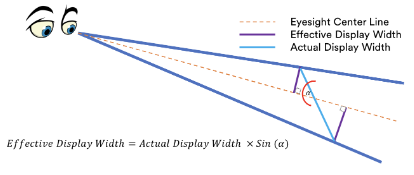
Maximum Noting Distance
If the effective size of a display within an observer’s gaze is larger than a minimum noting threshold, it can be considered an opportunity to see by that individual. As an observer moves farther away from a display, the effective size shrinks and passes the threshold at which the display can no longer be noticed. The distance at which the effective size is equal to the minimum noting threshold is defined as the maximum noting distance.
Within a store, or outside in a cluttered urban environment, a display needs to take up a larger proportion of an individual’s field of view to have an opportunity to be noticed. Along an interstate freeway in a rural area, a display will be noticed at a much farther distance as there are fewer visual distractions. We use Place Type and Area type (urbanicity) of the display to select the appropriate threshold defining when an observer has an opportunity to see a display.
As described above, the effective size of a unit in an observer’s field of view can be calculated using the size of the display, it’s orientation and the relative location of the observer (to calculate the distance and angle to the display). Given the minimum noting threshold for a display, it is then possible to calculate ALL locations where the effective size is equal to the maximum noting threshold. These points define the boundary of the Viewshed.
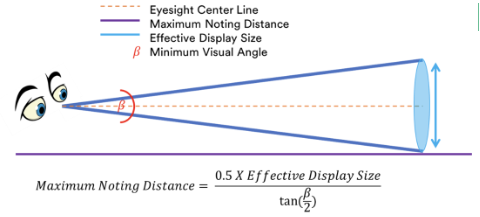
Best Practices
Selecting an arbitrary noting radius or distance is not enough to assess the audience reached by an OOH ad unit.
As you can see in this example, while this car was indeed captured within the radius of this ad unit, it had no opportunity to see the ad, only the back of the structure.
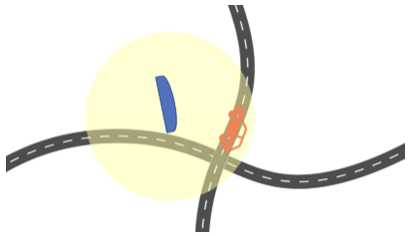
Each media display has its own unique viewshed and travel routes from which it can be seen.
Directionality
Even once an accurate viewshed is constructed, incremental assessments must be made to properly determine exposure.
Depending upon the approach of the audience, an ad unit may not be visible from all points within a viewshed. As a result, simply capturing devices “seen” in a viewshed is an invalid approach and will lead to misclassification of exposed audiences.
Even though the car below was captured within the viewshed of this ad unit, it did not have an opportunity to see it since it was traveling in the wrong direction.
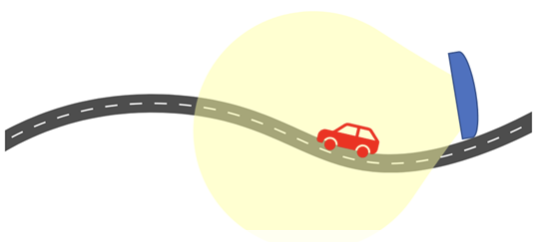
The viewshed is intersected with the moving field of view of the passers-by that is a function of
-
The orientation of the billboard
-
The direction of traffic passing the billboard
-
The distance of the billboard from the road
There is a point during the approach to an ad unit where the audience stops being able to see the display. The field of view of a driver is 120 degrees. Once the unit is past that point in the driver’s vision, the driver is no longer able to see the ad unit but is still within the viewshed.
Take this example:
At the bottom right of the image below, is a billboard, identified with a purple square. The viewshed for this display is shaded in yellow. A vehicle is approaching from the Northeast, circled in red. Once that vehicle crosses the blue line in its path, the billboard falls outside of the 120-degree field of view of the driver and is no longer visible for the remainder of its trip through the viewshed.
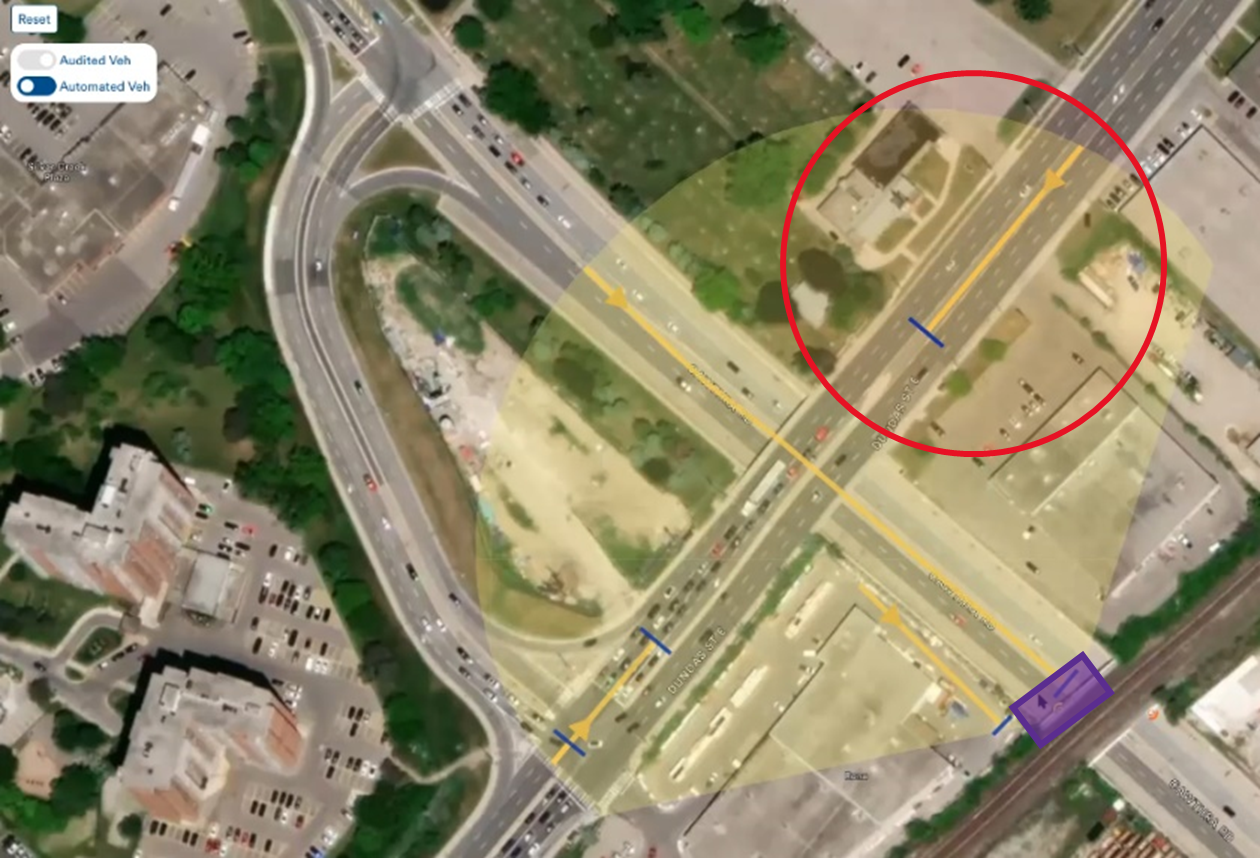
This is important when calculating the dwell time of the vehicle and especially vital for determining the number of ad plays this individual has the opportunity to see on a digital screen. The time required for the vehicle to pass entirely through the viewshed is more than twice as long as the actual dwell time for this in this example.
Visual Obstructions
Assessing the visibility of a display from different viewpoints is essential to determine the links and approaches from which the OOH can actually be seen. In the example viewshed below, it appears from the aerial view that the inventory can be seen from multiple approaches, all circled in red.
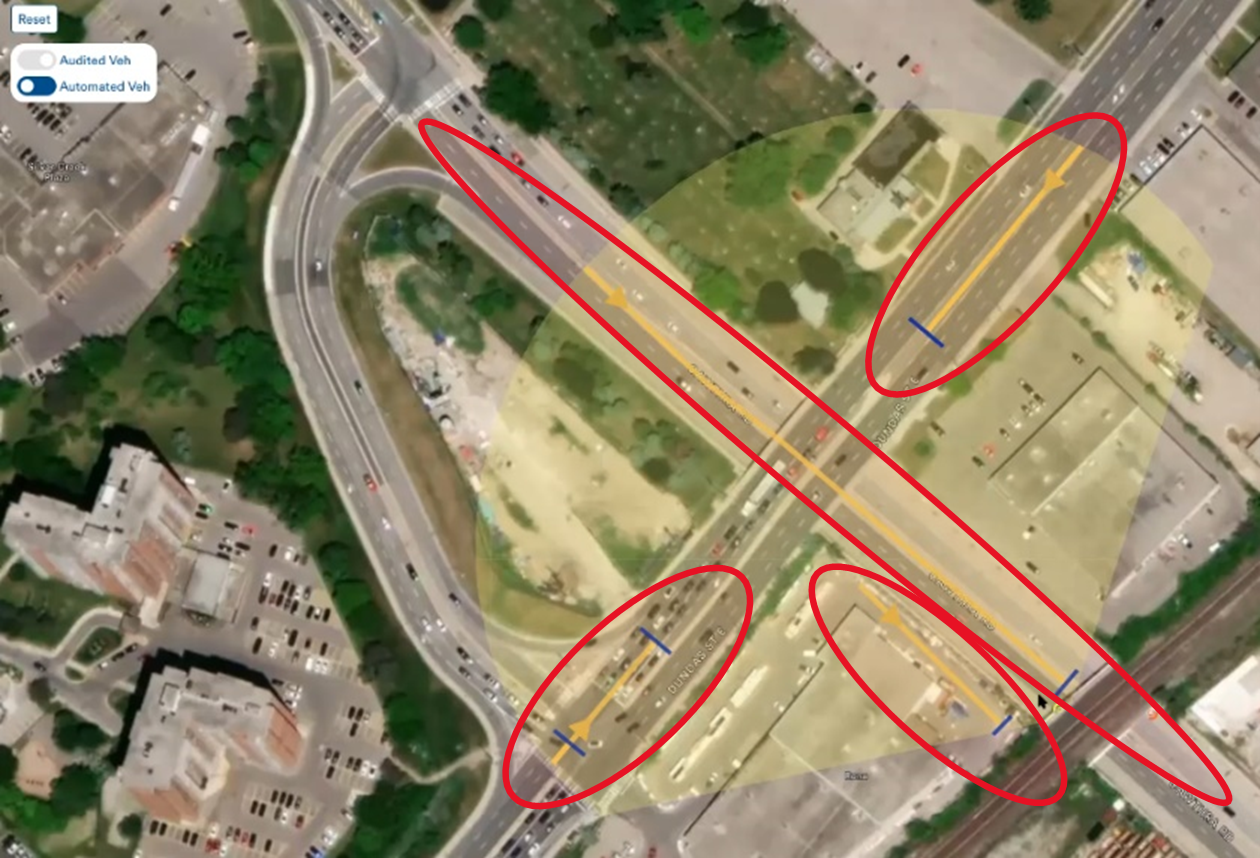
In reality there is only one approach from which this unit can be viewed, circled below. The unit is on the side of a train trestle. The roadway running Northeast to Southwest is an elevated overpass and none of the traffic has the opportunity to view the display. Additionally, the display is obscured from the view of the audience passing under that overpass until their vehicle is very close to the overpass itself.
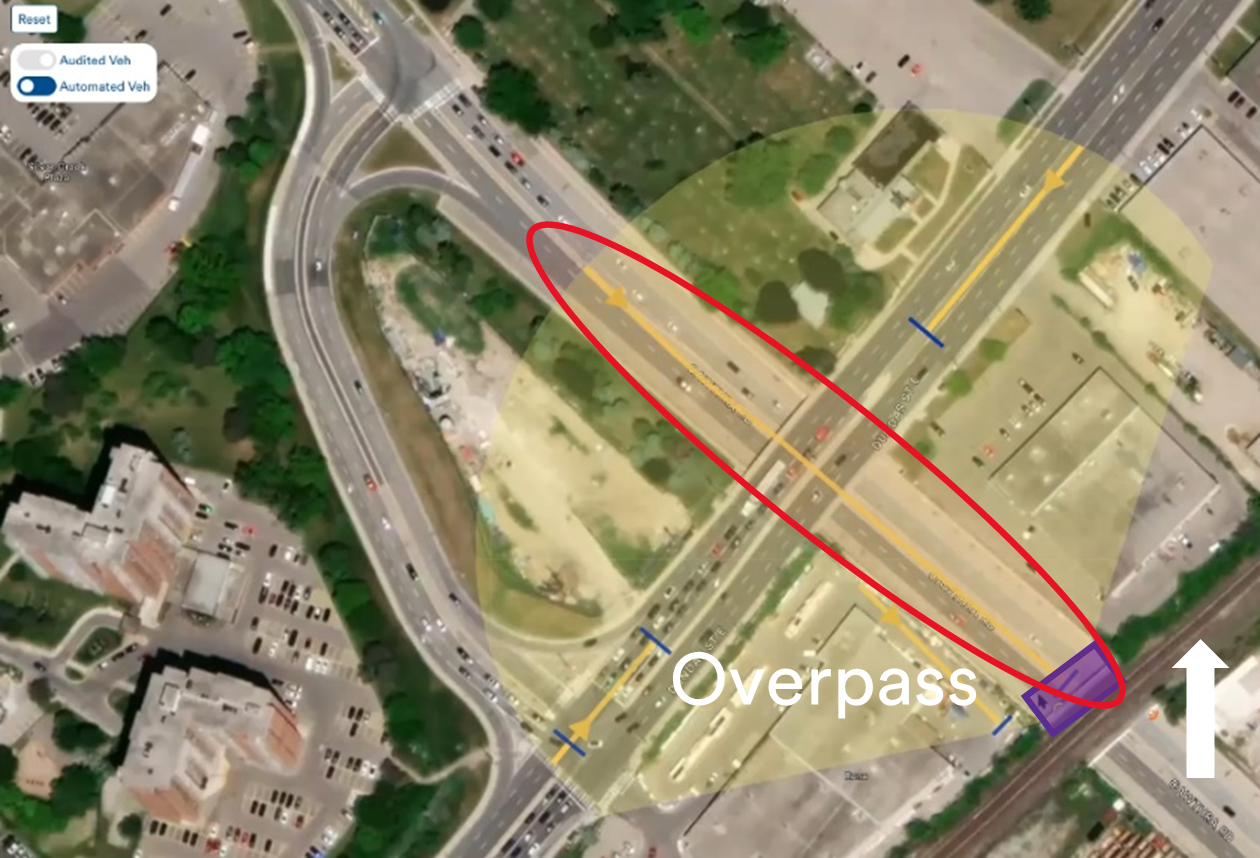
Utilizing a simulation to assess the visibility of the display from the vantage point of each approach rather than a simple aerial viewpoint is essential to ensure that the exposed audience is not inflated.
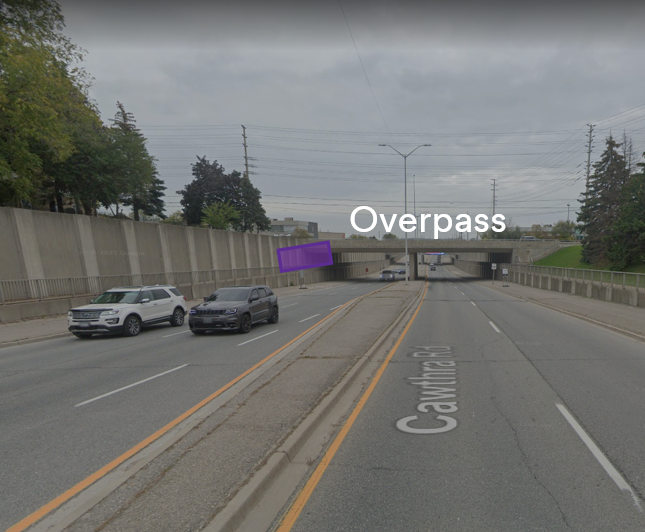
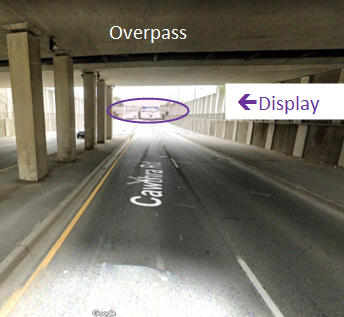
Accurately Identifying Exposed Audiences Outside of the Viewshed
It is not enough to consider only the devices that are captured within a viewshed as exposed to a media advertisement.
Delivery of location data from mobile devices varies in frequency. In some cases, a member of an exposed OOH audience may deliver a “ping” - meaning its latitude and longitude were captured - while within the viewshed.
In other cases, however, the device may deliver a ping before entering a viewshed, deliver nothing while in the viewshed, but then ping again on the other side of the viewshed.
The device had to have passed through that viewshed and should be included as having been exposed to the ad unit. In the example below, the blue car sent a location ping prior to the viewshed and then again after passing through it. Both the orange car and the blue car were exposed.
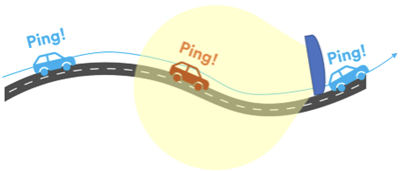
Pedestrian Traffic
Unlike vehicular traffic, pedestrians and people traveling on bikes, scooters, etc. may be moving in any direction and on any side of a given link. In fact, during their occupancy within the viewshed, individuals may move in multiple directions. They may be wandering around while taking a phone call, buying lunch from a food truck, or chatting with a friend, and not moving in a single linear direction. As a result, the majority of pedestrians that cross into the viewshed have an opportunity to see a display.

Glossary
Circulation
The total number of individuals passing a display within a specific time period regardless of whether or not they had an opportunity to see an advertisement.
Dwell Time
The amount of time an individual spends within the maximum noting distance of a media display.
Effective Size
The size that display appears within an individual’s field of view. It is dependent upon the angle the advertisement is in relation to the individual’s view as well as the distance from the viewer.
Display
The surface area on a media unit where advertising content is displayed. A structure may have more than one display.
Field of View
The area an individual can comfortably see at any given moment in time.
Likelihood to See Impressions
The portion of the OTS (Opportunity to See) audience who are likely to see an ad. This is determined by applying a visibility adjustment to the OTS audience utilizing methodologies including eye tracking studies and facial detection technologies.
Link
A distinct segment of road or pedestrian pathway.
Maximum Noting Distance
The point at which a display become large enough within the field of view of an individual for it to reach a specific threshold making it able to be consumed.
Opportunity to See Impressions
The measure of the audience that can see an display based upon their proximity, approach, and dwell time. This measure does not take into account whether or not the individual made eye contact with the display.
Orientation
The cardinal direction that a display faces.
Traffic
The count of vehicles or pedestrians passing a specific point. This value, by definition, is less than or equal to the circulation, a count of persons.
Viewshed
The geographic area from which an individual has an opportunity to see a display.
Out-of-Home (OOH) Media
Advertising displays located outside the home environment, including billboards, transit advertising, place-based digital displays, and street furniture advertising.
Updated 3 days ago
